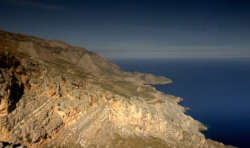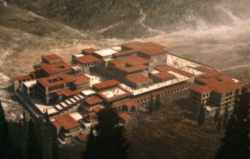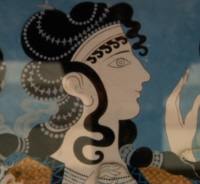Crete - Volcano
The Minoans
Andrew Marr’s History of the World - Age of Survival

The Greek island of Crete sits in an area prone to volcanic eruptions and earthquakes and this was the home of what’s been described as Europe’s first civilisation - the Minoans. So what does that mean, “civilisation”? Literally, “people living in towns and cities” but it implies more style, more polish and few civilisations have seemed as stylish as the Minoans.
3,700 years ago, the Minoans were pioneers of international trade. The shipped wine, olive oil and timber throughout the eastern Mediterranean. At the heart of the Minoan civilisation stood their great palace of Knossos.

In the early 1900s, Knossos was excavated by the British archaeologist Sir Arthur Evans. He discovered a sophisticated city that had frescos, aqueducts and even rudimentary plumbing. The frescos and figures of women holding snakes up to the sky suggest that women held a dominant position in Minoan culture. Sir Arthur Evans was entranced by the Minoans, and he decided to reconstruct their city.
There is something interestingly cool and modern about the Minoans style, something very 1920s, and that’s because it IS very 1920s.
The stonework is new and, as for the world-famous frescos, well, they’re based on fragments of Minoan art but they’ve been very, very seriously worked up. The beauties shimmying down to a beach party with their flagons of wine were famously described by the novelist Evelyn Waugh as being rather like the covers of Vogue magazine.

Evans excavated and rebuilt at a time when Europe was being torn apart by the First World War, and he presented the Minoan civilisation as a peaceful utopia.
Sir Arthur Evans imagined the Minoans ruling over a gentler, more peaceful Europe, far from the blood-soaked Europe of his own time.
The Minoan culture seemed idyllic, but first impressions are as dangerous in history as anywhere else. In 1979, the darker side of the Minoans was revealed. And that dark underside was first uncovered here at a little temple a few miles inland from Knossos. It seems a tiny, quiet fragment of Paradise today but when archaeologists started digging through the rubble, they made a satisfyingly gruesome discovery.

Now, on these stones, there was some kind of altar and on that the skeleton of a young man, about 18 years old, and across him was lying a bronze ceremonial dagger. The bones on the upper part of his body were white and on the lower part black, indicating to archaeologists that his heart had still been beating as the blood was draining from his body. He’d bled to death. He was a human sacrifice.
Two other bodies were discovered, one was the body of a woman, just over 5 foot high, of medium build, and her hands were trying to protect her face. Now we know that women had high status in Minoan society, and it’s possible, even probable, that she was a priestess.
Minoan society was highly developed, but they lived in fear of the natural forces surrounding them, and their desire to control nature wasn’t matched by their ability. So they responded with the ultimate religious ritual in an attempt to appease the gods they believed controlled the natural world.
Around 3,700 years ago, during this gory sacrifice, nature struck again. Trying to police nature has always been the ultimate human challenge. It still is. All their attempts to placate the gods having failed, the Minoan civilisation was devastated.
The Minoans will always be a mysterious people… And yet they do remind us of the fundamental truth, which is that although the journey from caves to civilisation has been awesome, there would be no final victories - certainly not over nature, nor over the darker side of human nature.
